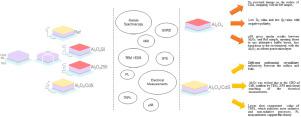Applied Materials Today ( IF 7.2 ) Pub Date : 2020-11-13 , DOI: 10.1016/j.apmt.2020.100867 M.A. Curado , J.P. Teixeira , M. Monteiro , E.F.M. Ribeiro , R.C. Vilão , H.V. Alberto , J.M.V. Cunha , T.S. Lopes , K. Oliveira , O. Donzel-Gargand , A. Hultqvist , S. Calderon , M.A. Barreiros , W. Chiappim , J.P. Leitão , A.G. Silva , T. Prokscha , C. Vinhais , P.A. Fernandes , P.M.P. Salomé

|
In the past years, the strategies used to break the Cu(In,Ga)Se2 (CIGS) light to power conversion efficiency world record value were based on improvements of the absorber optoelectronic and crystalline properties, mainly using complex post-deposition treatments. To reach even higher efficiency values, further advances in the solar cell architecture are needed, in particular, with respect to the CIGS interfaces. In this study, we evaluate the structural, morphological and optoelectronic impact of an Al2O3 layer as a potential front passivation layer on the CIGS properties, as well as an Al2O3 tunneling layer between CIGS and CdS. Morphological and structural analyses reveal that the use of Al2O3 alone is not detrimental to CIGS, although it does not resist to the CdS chemical bath deposition. The CIGS optoelectronic properties degrade when the CdS is deposited on top of Al2O3. Nonetheless, when Al2O3 is used alone, the optoelectronic measurements reveal a positive impact of this inclusion such as a very low concentration of interface defects while keeping the same CIGS recombination channels. Thus, we suggest that an Al2O3 front passivation layer can be successfully used with alternative buffer layers. Depth-resolved microscopic analysis of the CIGS interface with slow-muons strongly suggests for the first time that low-energy muon spin spectroscopy (LE-µSR) is sensitive to both charge carrier separation and bulk recombination in complex semiconductors. The demonstration that Al2O3 has the potential to be used as a front passivation layer is of significant importance, considering that Al2O3 has been widely studied as rear interface passivation material.
中文翻译:

使用Al 2 O 3对Cu(In,Ga)Se 2太阳能电池进行前钝化:罪魁祸首和益处
在过去的几年中,用于打破Cu(In,Ga)Se 2(CIGS)光到功率转换效率世界纪录值的策略是基于吸收体光电和晶体性能的改善,主要是采用复杂的后沉积处理。为了达到更高的效率值,特别是在CIGS接口方面,需要进一步提高太阳能电池的结构。在这项研究中,我们评估了作为潜在正面钝化层的Al 2 O 3层对CIGS特性以及在CIGS和CdS之间的Al 2 O 3隧穿层的结构,形态和光电影响。形态和结构分析表明,Al 2的使用单独使用O 3不会损害CIGS,尽管它不能抵抗CdS化学浴的沉积。当CdS沉积在Al 2 O 3之上时,CIGS的光电性能下降。尽管如此,当单独使用Al 2 O 3时,光电测量显示了这种夹杂物的积极影响,例如界面缺陷浓度非常低,同时保持了相同的CIGS复合通道。因此,我们建议Al 2 O 3前钝化层可以成功与其他缓冲层一起使用。CIGS界面与慢速μ子的深度分辨显微镜分析首次强烈表明,低能量μ子自旋光谱法(LE-µSR)对复杂半导体中的电荷载流子分离和体复合均敏感。考虑到已经广泛研究了Al 2 O 3作为后界面钝化材料,因此证明Al 2 O 3具有用作前钝化层的潜力非常重要。











































 京公网安备 11010802027423号
京公网安备 11010802027423号